Product Categories
SHOP BY ARTIST
NEWSLETTER
Twin Rocks
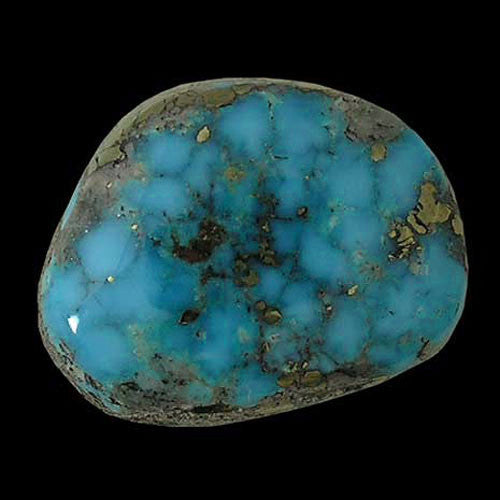
11.21 cts Natural Gem Grade Morenci Turquoise Cabochon (#15)
$224.00$300.00
Natural Morenci Turquoise
11.21 cts.
1/2" tall x 5/8" wide
We offer a 100% satisfaction guarantee on every purchase.
Morenci Turquoise; Arizona Mine, Morenci, Clifton-Morenci District, Shannon Mountains, Greenlee County, Arizona, USA. An open pit copper mine located in the N1⁄2 Section 16, T4S, R29E (Clifton 15 minute topographic map), owned by Phelps Dodge Corp. Map Reference: 33°5'26"N , 109°21'58"W.
Morenci turquoise was mined in southeastern Arizona until approximately 1990. It is located very near the New Mexico border, and ranges in color from classic high electric blue to light azure. Prehistoric Indians who valued the stone for its deep blue color were the first to discover the deposit. These people adorned themselves with rough hewn beads and carved talisman made from the mineral
Morenci is often associated with an unusual black matrix of irregular iron pyrite, which looks metallic when polished. Although they are rare, stones with unusual birds-eye patterns, red matrix and an occasional layer of silver have also been found. The Morenci name is derived from the large open pit copper mine owned and operated by the Phelps Dodge Corporation. Early examples of this striking turquoise were of the "lunch box" variety, meaning they were carried out of the mine by workers and miners.
Morenci is well known; it was one of the first types of American turquoise to find its way to the market and is always difficult to obtain because the mine was depleted so long ago. It is believed that the best Morenci ever produced was discovered in the late 1960's to early 70's. During this time period, the mine produced a high, electric blue variety with iron pyrite inclusions. Since Morenci is no longer being mined, and because of its striking color and unusual matrix combinations, high grade natural Morenci is a valuable, highly collectible mineral.
USGS; Arizona.--In Arizona turquoise ranks first in terms of value of production and is also the best known of its gem materials. Nearly all important deposits of turquoise are located near copper occurrences or in copper deposits in arid desert regions of the world. Thus, the world famous turquoise deposits associated with certain of the large Arizona copper deposits are to be expected.
Turquoise is, or has been, mined from a number of these copper mines as a byproduct, usually by outside contractors. The financial and operating terms of the collecting contracts vary from mine to mine. Some of the operations are little more than the efforts of individual commercial collectors; some are essentially full-scale mining operations that are simultaneous with, but separate from, the regular mining operations; and still others operate on an on-call basis as turquoise is uncovered by the regular copper mining operation. Regardless of the size or sophistication of the initial mining or recovery operation, the actual turquoise is recovered by careful extraction using hand methods.

110 ct Blue Gem Turquoise Cabachon (#13)
$2,750.00
Natural Turquoise Cabachons
2" x 1 1/4"
This is a monster piece of super high-grade natural Blue Gem turquoise. The Blue Gem mine near Battle Mountain, Nevada was long ago pulverized and processed for copper and other precious metals, so turquoise from this location is no longer available. This extremely hard stone was cut and polished by the DePriest family of Manassa, Colorado in the 1970s. We bought a collection from Gary DePriest in the 90s and finally decided it needs a new home. This baby has waited far too long to have its natural beauty and unique character exposed.
We offer a 100% satisfaction guarantee on every purchase.
Blue Gem Turquoise
Blue Gem turquoise occurs in argillized quartz monzonite cut by two limonite-stained sheer zones, one trending N 35 o W and dipping 75 o NE, the other trending N, 25 o E and dipping 55 o NW. An extensive breccia zone about 10 feet wide is developed between the two bounding sheers. Exceptionally good quality turquoise forms veins up to three-quarters of an inch thick along the shears. Pyrite-bearing quartz veins are closely associated with the turquoise.
The Blue Gem mine was at one time located deep underground, accessed by tunnels as deep as 800 feet. This is of interest because the Blue Gem Mine and the Bisbee Mine in Arizona are the only two mines (of which we are aware) that turquoise was found that deep in the earth. The Blue Gem mine was once developed in extensive underground workings and open stoops. An audit several hundred feet long on the main structure connected to numerous shorter tunnels and several open stoops. Directly above the main audit was a glory hole some 100 feet long.
Duke Goff first noted the Blue Gem deposit in 1934. It was subsequently leased from the Copper Canyon Mining Co. by the American Gem Co. of San Gabriel, CA., owned by Doc Wilson and his sons, Del and William. The company operated the property until 1941 when the outbreak of the war caused a shortage of experienced miners. Both Del and William Wilson were called into the Army for the duration of the war, and this compelled the closing of the mine. Consequently, the lease was allowed to lapse and work was abandoned. In 1950 Lee Hand and Alvin Layton of Battle Mountain leased the mine.
Production of turquoise at the Blue Gem lease in the early days of the operation was enormous. Although there is no exact information, it is reported that the output amounted to nearly
$1 million in rough turquoise. The mine is still active, although Duval Corp is currently in the center of a major copper deposit developing it.
Pyrite in Blue Gem is unusual to see but not unheard of. Very little large material ever came out of Blue Gem, the majority found was small 1-mm "bleeder" veins and tiny nuggets which was perfect for Zuni inlay and fine needlepoint, petit-point and snake-eyes jewelry. Blue Gem turquoise was very popular in the late 1930's and 40's and was commonly used in the Fred Harvey "tourist jewelry" that is so collectable today. Blue Gem turquoise is extremely hard and stands up well to the test of time.
Blue Gem turquoise is a rare, valuable and historic American treasure. Quality Blue Gem Turquoise has been gifted with a wide range and variety of color. Because Blue Gem turquoise is very hard, a high polish is associated with this stone, and unlike most turquoise, won't easily change color. This turquoise has a unique character and many different looks all of which are striking, full of wonder and pleasing to the eye.
Production of the mine started about 1934 and continued into the 1970's. Blue Gem Turquoise is still some of the finest turquoise ever found, and unlike most turquoise mines, (in which the majority mined is chalky and only usable if stabilized) most of the turquoise found there was of gem-quality. Today the Blue Gem mine is not viable; it sits in the middle of a huge mining operation. The emphasis is on precious metals and the extraction of turquoise is considered more of a hindrance in the mining process rather than an asset. Even the ever-popular "Dump Diving" for turquoise through the overburden is not tolerated due to the very real danger of becoming buried in a slide. Insurance factors, equipment hazards, high explosives and safety issues along with a lack of interest from the mining company keep Blue Gem turquoise unavailable to the world, at least for now.
Related legends:
Precious Stones
Turquoise; Precious stones have symbolic implications. For example, turquoise if a "collective term for all the precious stones, wealth, or mixed offerings. Good fortune is attributed to this stone." Both white shell and turquoise are emphasized in Kinaalda? More about this legend

1920's Hupa Doll Size Baby Carrier (#06)
$395.00
Folk Art
6" x 12 1/2"
During the 1980's and 1990's Georgiana was traveling the back-roads of California and Nevada, buying, selling, trading and collecting. This fine little Hupa baby carrier was one of her acquisitions. Made in the 1920's with hazel branches and conifer wrapping, it would have been the envy of every Hupa mother in training.
We offer a 100% satisfaction guarantee on every purchase.
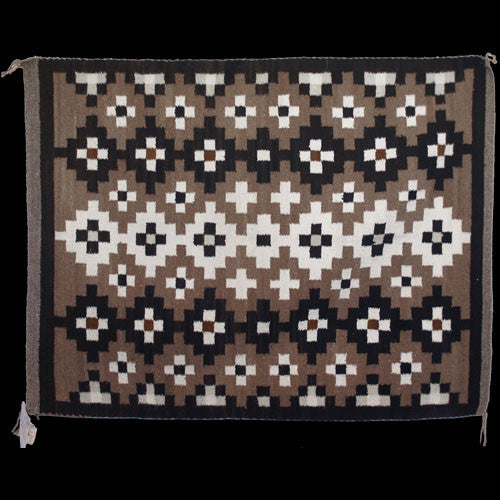
1930's Navajo Duality Symbol Rug (#54)
$800.00
There is something warm, fuzzy and wonderful about an old, hand-woven, Navajo rug. To know that some hard-working individual sheared the sheep, cleaned, carded and spun the wool is amazing because the job is so labor intensive. This particular textile has some age on it. It was woven sometime in the 1930's and then put away. There is absolutely no wear on this rug. It’s in pristine condition. Duality crosses pertain directly to the basis of Navajo culture, which are Hozho, harmony and balance. Nothing could be more closely associated to Navajo tradition than this piece of art.
Related legends:
Symbolism
The hoop ceremonies of the Navajo have been compared by anthropologists to mandalas, Paleolithic sunwheels, or "magic circles." Spruce, willow, and other hoops represent the four passages of man through the four elemental worlds. They are also symbolic of the four directions, the four sacred mountains, the four-cornered construct of the human family mother, father, son, daughter and the four stages of human life? More about this legend
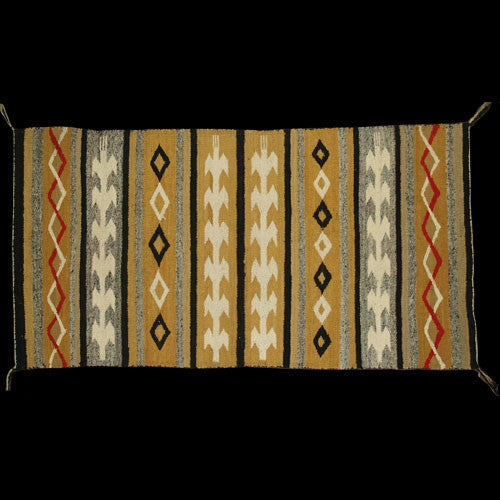
1950's Hand Spun Wool Naslini Corn Rug (#34)
$850.00
Navajo Rugs
59" x 38"
To the Navajo, corn is the fruit of life. Images of the corn plant stand as a metaphor for connections to the past, present and future along with perceptions of the upward moving way. This fun and fluffy, 1960's era textile comes to us through a Nevada estate sale. It is completely hand spun and is accented with vegetable dyes. Navajo rugs don't get any earthier or homegrown than this.
We offer a 100% satisfaction guarantee on every purchase.
Related legends:
Weaving
After the medicine woman told the people about the prayersticks she told them that there was a place in the underworld where two rivers crossed. It was called ni tqin'kae tsosi, fine fiber cotton (Indian hemp). There were two persons who brought the seed of that plant, they were spiders. They said that the people were to use the plant instead of skins for their clothing. So this seed was planted in the earth? More about this legend
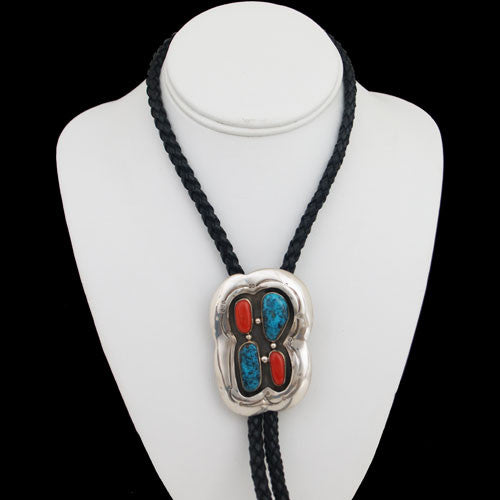
1960's Blue Diamond Turquoise and Coral Bolo Tie (#52)
$495.00
Bolo: 2" x 2 3/4"
Strap: 44" long
This antique bolo tie from the 1960s is fashioned with Blue Diamond turquoise and Mediterranean coral. Using a shadowbox style to showcase the first-rate stones, the unknown artist put together an interesting work that has stood the test of time.
Related legends:
Silversmith Work
When and how the Navajo acquired the art of working metals is unknown but there are reasons for supposing that it was introduced among them, or at least more developed and improved upon by them, since the time they have occupied their present country?
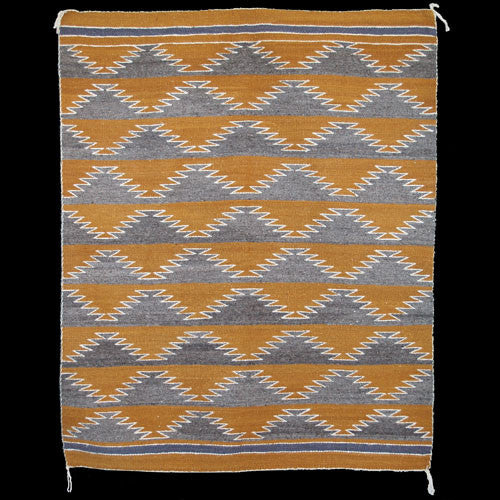
1960's Crystal Rug (#27)
$950.00
Navajo Rugs
49 1/2" x 40 1/2"
Hand-spun rugs are an anachronism. They are so labor intensive it is a wonder they are ever woven. And these days they are often not. This fine example was woven in the 1960s and features natural wool and plant dyes, nothing unnatural. The rug can be used on the floor or on the wall. It will be great anywhere.
We offer a 100% satisfaction guarantee on every purchase.
Related legends:
Crystals
First Man burned a crystal for a fire. The crystal belonged to the male and was the symbol of the mind and of clear seeing. When First Man burned it, it was the mind's awakening? More about this legend
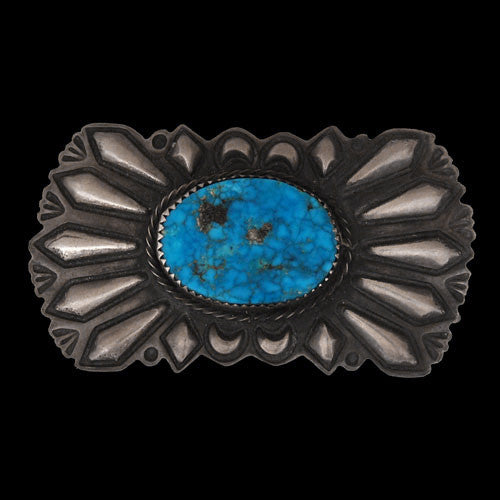
1970s Silver & Water Web Morenci Turquoise Pin (#42)
$420.00
Navajo Jewelry
1970s Handmade silver pin set with natural, Water Web Morenci turquoise
2 1/2" wide x 1 3/8" tall
14 carats of Morenci turquoise
Twin Rocks Private Reserve
This broach is what we call a "filler pin". Navajo women would wear a broach like this at the collar between the V strands of beads and turquoise of a squash blossom necklace. We collected this piece in the mid 1970's because it contains a stunning piece of high-grade, natural water-web Morenci turquoise. Steve and I have argued about whether or not to unset the stone and place it in something more "jewelry familiar" or leave it as it was first set. As you can see we are giving the piece a chance to grace someone's collection as it was initially crafted. This is a great piece of Navajo jewelry created to be worn by Native peoples.
We offer a 100% satisfaction guarantee on every purchase.
Related legends:
Silversmith Work
When and how the Navajo acquired the art of working metals is unknown but there are reasons for supposing that it was introduced among them, or at least more developed and improved upon by them, since the time they have occupied their present country?
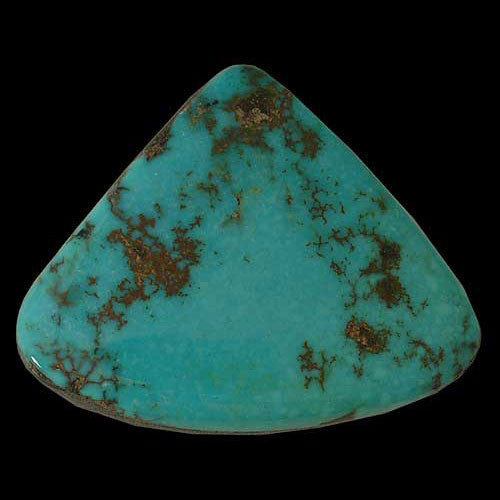
42.18 cts Natural Gem Grade Morenci Turquoise Cabochon (#6)
$845.00
Natural Morenci Turquoise
42.18 cts.
1 1/8" tall x 1 3/8" wide
We offer a 100% satisfaction guarantee on every purchase.
Morenci Turquoise; Arizona Mine, Morenci, Clifton-Morenci District, Shannon Mountains, Greenlee County, Arizona, USA. An open pit copper mine located in the N1⁄2 Section 16, T4S, R29E (Clifton 15 minute topographic map), owned by Phelps Dodge Corp. Map Reference: 33°5'26"N , 109°21'58"W.
Morenci turquoise was mined in southeastern Arizona until approximately 1990. It is located very near the New Mexico border, and ranges in color from classic high electric blue to light azure. Prehistoric Indians who valued the stone for its deep blue color were the first to discover the deposit. These people adorned themselves with rough hewn beads and carved talisman made from the mineral
Morenci is often associated with an unusual black matrix of irregular iron pyrite, which looks metallic when polished. Although they are rare, stones with unusual birds-eye patterns, red matrix and an occasional layer of silver have also been found. The Morenci name is derived from the large open pit copper mine owned and operated by the Phelps Dodge Corporation. Early examples of this striking turquoise were of the "lunch box" variety, meaning they were carried out of the mine by workers and miners.
Morenci is well known; it was one of the first types of American turquoise to find its way to the market and is always difficult to obtain because the mine was depleted so long ago. It is believed that the best Morenci ever produced was discovered in the late 1960's to early 70's. During this time period, the mine produced a high, electric blue variety with iron pyrite inclusions. Since Morenci is no longer being mined, and because of its striking color and unusual matrix combinations, high grade natural Morenci is a valuable, highly collectible mineral.
USGS; Arizona.--In Arizona turquoise ranks first in terms of value of production and is also the best known of its gem materials. Nearly all important deposits of turquoise are located near copper occurrences or in copper deposits in arid desert regions of the world. Thus, the world famous turquoise deposits associated with certain of the large Arizona copper deposits are to be expected.
Turquoise is, or has been, mined from a number of these copper mines as a byproduct, usually by outside contractors. The financial and operating terms of the collecting contracts vary from mine to mine. Some of the operations are little more than the efforts of individual commercial collectors; some are essentially full-scale mining operations that are simultaneous with, but separate from, the regular mining operations; and still others operate on an on-call basis as turquoise is uncovered by the regular copper mining operation. Regardless of the size or sophistication of the initial mining or recovery operation, the actual turquoise is recovered by careful extraction using hand methods.
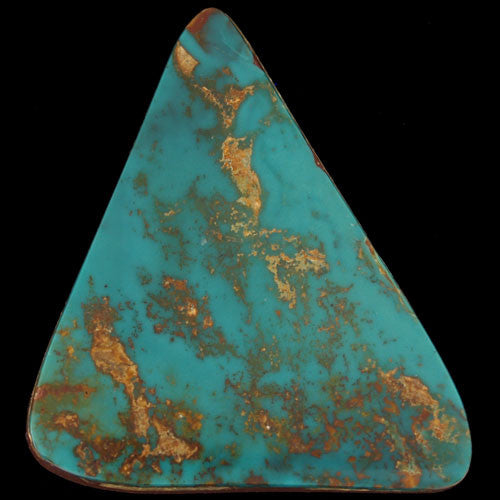
82 cts Natural Gem Grade Blue Gem Turquoise Cabochon (#20)
$3,280.00
You see before you an 82-carat cabochon of super-fine, high-grade, natural Blue Gem turquoise from Battle Mountain, Nevada, USA. This stone has so much character it seems unreal. The bright and beautiful blue/green color is simply amazing. The Blue Gem turquoise mine once produced some of the best turquoise ever unearthed. This stone was mined and cut in the mid 1970s, the heyday of Blue Gem production. Beauty, rarity and durability, this stone has all that and more.
Blue Gem Turquoise
Blue Gem turquoise occurs in argillized quartz monzonite cut by two limonite-stained sheer zones, one trending N 35 o W and dipping 75 o NE, the other trending N, 25 o E and dipping 55 o NW. An extensive breccia zone about 10 feet wide is developed between the two bounding sheers. Exceptionally good quality turquoise forms veins up to three-quarters of an inch thick along the shears. Pyrite-bearing quartz veins are closely associated with the turquoise.
The Blue Gem mine was at one time located deep underground, accessed by tunnels as deep as 800 feet. This is of interest because the Blue Gem Mine and the Bisbee Mine in Arizona are the only two mines (of which we are aware) that turquoise was found that deep in the earth. The Blue Gem mine was once developed in extensive underground workings and open stoops. An audit several hundred feet long on the main structure connected to numerous shorter tunnels and several open stoops. Directly above the main audit was a glory hole some 100 feet long.
Duke Goff first noted the Blue Gem deposit in 1934. It was subsequently leased from the Copper Canyon Mining Co. by the American Gem Co. of San Gabriel, CA., owned by Doc Wilson and his sons, Del and William. The company operated the property until 1941 when the outbreak of the war caused a shortage of experienced miners. Both Del and William Wilson were called into the Army for the duration of the war, and this compelled the closing of the mine. Consequently, the lease was allowed to lapse and work was abandoned. In 1950 Lee Hand and Alvin Layton of Battle Mountain leased the mine.
Production of turquoise at the Blue Gem lease in the early days of the operation was enormous. Although there is no exact information, it is reported that the output amounted to nearly
$1 million in rough turquoise. The mine is still active, although Duval Corp is currently in the center of a major copper deposit developing it.
Pyrite in Blue Gem is unusual to see but not unheard of. Very little large material ever came out of Blue Gem, the majority found was small 1-mm "bleeder" veins and tiny nuggets which was perfect for Zuni inlay and fine needlepoint, petit-point and snake-eyes jewelry. Blue Gem turquoise was very popular in the late 1930's and 40's and was commonly used in the Fred Harvey "tourist jewelry" that is so collectable today. Blue Gem turquoise is extremely hard and stands up well to the test of time.
Blue Gem turquoise is a rare, valuable and historic American treasure. Quality Blue Gem Turquoise has been gifted with a wide range and variety of color. Because Blue Gem turquoise is very hard, a high polish is associated with this stone, and unlike most turquoise, won't easily change color. This turquoise has a unique character and many different looks all of which are striking, full of wonder and pleasing to the eye.
Production of the mine started about 1934 and continued into the 1970's. Blue Gem Turquoise is still some of the finest turquoise ever found, and unlike most turquoise mines, (in which the majority mined is chalky and only usable if stabilized) most of the turquoise found there was of gem-quality. Today the Blue Gem mine is not viable; it sits in the middle of a huge mining operation. The emphasis is on precious metals and the extraction of turquoise is considered more of a hindrance in the mining process rather than an asset. Even the ever-popular "Dump Diving" for turquoise through the overburden is not tolerated due to the very real danger of becoming buried in a slide. Insurance factors, equipment hazards, high explosives and safety issues along with a lack of interest from the mining company keep Blue Gem turquoise unavailable to the world, at least for now.
Related legends:
Precious Stones Turquoise; Precious stones have symbolic implications. For example, turquoise if a "collective term for all the precious stones, wealth, or mixed offerings. Good fortune is attributed to this stone." Both white shell and turquoise are emphasized in Kinaalda? More about this legend
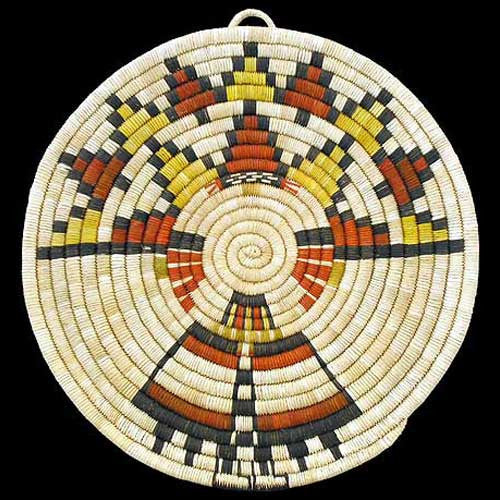
Hopi Early Morning Coil Basket (#04)
$1,250.00
12 1/2"
Hopi basket makers make some of the finest basketry in North America. Many Puebloan people no longer weave baskets, but a select few Hopi women continue this centuries-old tradition. This weaving of a Hopi Sun Face Katsina is skillfully arranged and reflects upon symbolism and tradition in Hopi design. Each Hopi basket is linked to aspects of Hopi life, past and present. In particular, basketry designs reflect aspects of Hopi religion and agriculture. For the Hopi, just as the basket's fibers are woven together, so are all the pieces of Hopi culture: none is unrelated to another.
Related legends:
Holy Ones
The meaning of the word hashch'e (Holy Ones) as employed in the names of some of the gods is not generally known. Moreover, it is not generally made public by the knowing ones who guard its meaning as a secret. Hashch'eltqii, the Talking God of the east, is the child of hayolkhal hastqin and hayolkhal esdza, to the Dawn Man and Woman? More about this legend
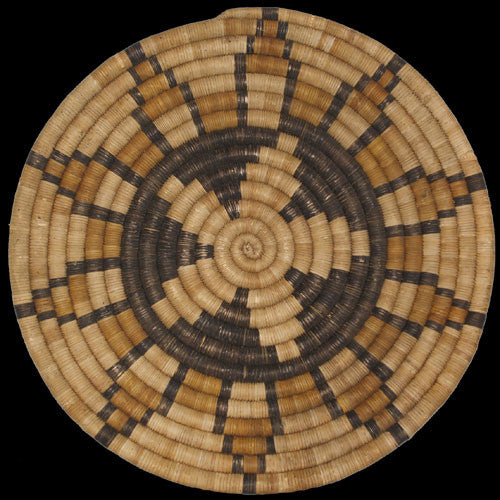
Hopi Star Design Basket Tray (#16)
$360.00
Hopi Basket
13 3/4" x 15 rounds
From the John Richardson collection, this 1960s Hopi tray has arrived at the trading post looking for a new home. Made with yucca fibre and natural dyes, it is in reasonably good condition. After about 50 years, it has accumulated a few breaks along the rim, but otherwise the old gal is in shapely.
We offer a 100% satisfaction guarantee on every purchase.
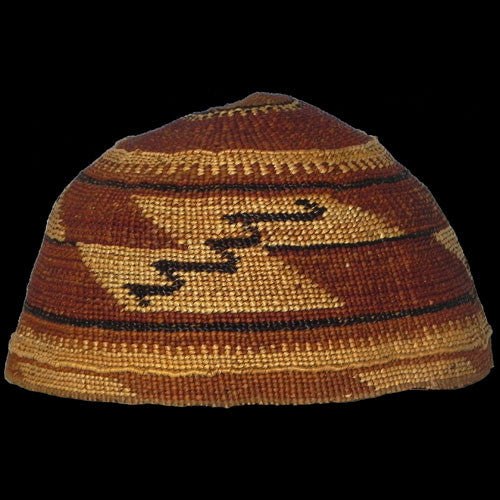
Late 1900's Karok Basketry Hat w/ Obsidian Blade Design (#03)
$1,195.00
Baskets
7" x 4"
In Northern California, Karok weavers were known for their ceremonial basket hats. This particular weaving dates from around 1900 and features an obsidian blade design. Hazel branches are used for the foundation while bear grass, maidenhair fern woodwardia are used to create the design. Steve and Georgiana Simpson collected this basket.
We offer a 100% satisfaction guarantee on every purchase.
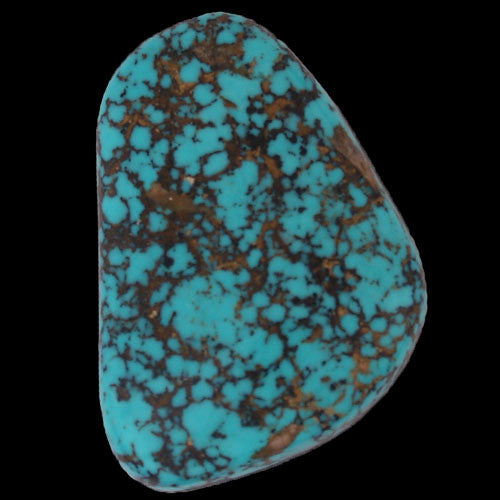
Natural 64.4cts High Grade Pilot Mountain Turquoise Cabochon (#02)
$1,610.00
Width: 1.04"
Thickness: .30"
Barry has released one of the premier gems from his private stash, which does not often happen. This Pilot Mountain cabochon was guarded for many years, but recently Barry has turned loose of it. At just over 64 carats, this is an exceptional stone.
Pilot Mountain Turquoise
The Pilot Mountain turquoise mine is also known as Montezuma or Troy Springs. The mining claim is actually made up of a group of small diggings located in Mineral County, west-central Nevada, at the southern end of the Pilot Mountains, just 14 miles east-southeast from Mina.
In 1905 William Miller of Tonopah, Nevada discovered what he called the Montezuma. The current owner, however, is headquartered in Manassa, Colorado. The property was initially claimed as a copper mine, but it was soon discovered that particular mineral was in short supply. High-grade turquoise, however, was plentiful. Copper production ceased and the area was restructured for turquoise production.
Pilot Mountain turquoise is hard, with colors ranging from a bright blue to dark blue with a greenish cast, and at times even an exceptionally dark blue. Strong deep brown limonite mottled patterns are associated with this stone. Pilot Mountain, though thinly veined, is a beautiful gem turquoise. This Nevada mine is one of the gem locations, which became famous for its extremely rare dendrites (manganese plant fossil replacements). The mine also produced some exceptionally high-grade spider web turquoise featuring interesting web matrix patterns that include red, brown and black tones. It is a hard stone, so it takes a high shine that retains color longer and is less resistant to skin oils.
Related legends:
Precious Stones Turquoise; Precious stones have symbolic implications. For example, turquoise if a "collective term for all the precious stones, wealth, or mixed offerings. Good fortune is attributed to this stone." Both white shell and turquoise are emphasized in Kinaalda? More about this legend
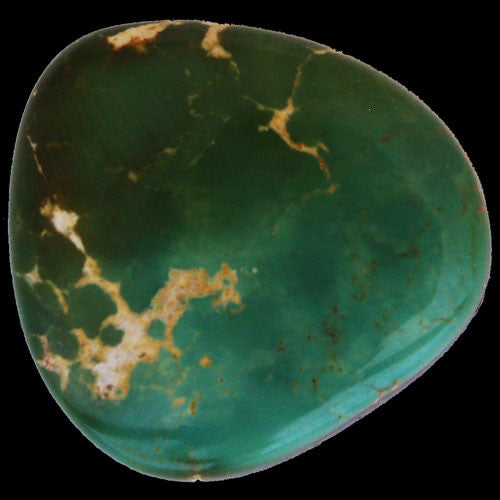
Natural Gem Grade 24cts Candaleria Turquoise Cabochon (#02)
$600.00
Natural Turquoise Cabochons
7/8" x 7/8"
Candelaria turquoise was mined in a mean and primitive area of the Candelaria Hills near Tonopah, Nevada. Much of the turquoise from the Candelaria mine was of a deep electric blue but, occasionally, a lovely green stone was brought to light. This particular stone is just such a specimen. It is super hard, which is the reason for the high shine and superior polish. For having been extracted from one of the most inhospitable places in the USA this stone is highly refined.
We offer a 100% satisfaction guarantee on every purchase.
Candaleria Turquoise
From the flanks of Mt. Diablo comes a rare an unusual find. Candaleria, Nevada was once a boomtown for silver, gold and then copper. Now it is a scrapped out ghost town sitting on the edge of a vast hole in the ground. In the 1970's a good deal of high grade, natural turquoise was pulled from that pit; sent to Manassa, Colorado to be cut and polished; then sent around the country to be set in jewelry of all types.
Related legends:
Precious Stones
Turquoise; Precious stones have symbolic implications. For example, turquoise if a "collective term for all the precious stones, wealth, or mixed offerings. Good fortune is attributed to this stone." Both white shell and turquoise are emphasized in Kinaalda? More about this legend
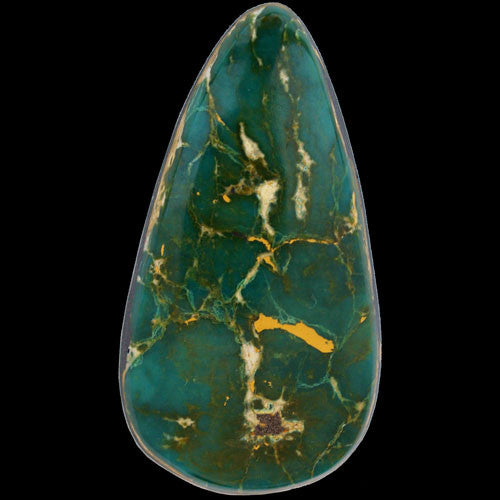
Natural Gem Grade 43.7cts Persian Turquoise Cabochon (#02)
$437.00
Natural Turquoise Cabochons
43.7 cts
1" x 1 3/4"
This crazy green turquoise with mellow yellow matrix came to us from far distant lands. Persia is well known for producing turquoise of a very high quality and this particular stone fits that designation extremely well. The stone is super hard, which is the reason behind its high shine. It is altogether natural and was cut here in the states by John Huntress of Santa Fe, NM.
We offer a 100% satisfaction guarantee on every purchase.
Persian Turquoise
In the Southwest, we tend to take turquoise for granted; yet it has been labeled the “Gemstone of the Centuries”. Over 7,500 years ago, slave convoys were sent into the Sinai Peninsula to pluck pieces of the blue gem from the rocks where it had formed. In ancient Egypt, turquoise was believed to have mystical powers and appeared in amulets and talisman representing their gods Amum and Isis. A gold and carved turquoise bracelet was found on the mummified arm of Queen Zer, a ruler during the first dynasty of Egyptian pharaohs. The four bracelets found in her burial are the earliest known examples of precious metal jewelry.
The Middle East emerged as the great purveyor of turquoise, supplying the ancient Egyptians, Nubians, Greeks and Romans. It is believed the name was derived from the French word, Turquie, a reference to the Turkish traders first bringing the rich blue stones to the European continent. It was assumed that the brilliant blue and green stones originated in Turkey when, in fact, they were most likely extracted from mines in the Sinai Peninsula and the Alimersai Mountain in Persia (Iran).
Related legends:
Precious Stones
Turquoise; Precious stones have symbolic implications. For example, turquoise if a "collective term for all the precious stones, wealth, or mixed offerings. Good fortune is attributed to this stone." Both white shell and turquoise are emphasized in Kinaalda? More about this legend
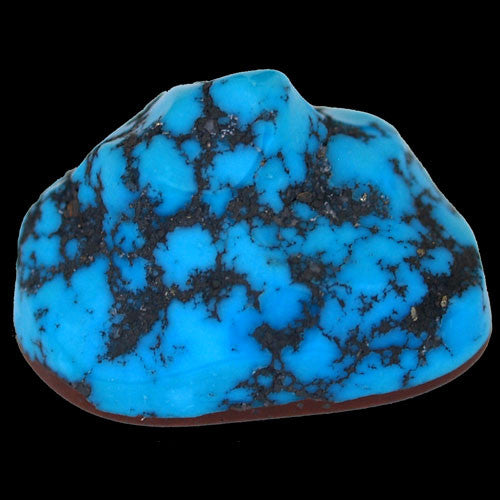
Natural Gem Grade 67 cts Castle Dome Turquoise Cabochon (#02)
$1,675.00
Natural Turquoise Cabochon
1 1/4" x 1" x 3/4"
The Castle Dome turquoise mine can be found in the Sleeping Beauty mountains of southeastern, AZ. The mine is located just over the hill from the Sleeping Beauty turquoise deposits. The property was mined-out in the early 1970's and the diggings were covered and reclaimed. Most of the turquoise produced by the mine was thin vein material and dime size nuggets. Castle Dome turquoise is, on average, of a better color and quality than its sister mine. This stone came from a batch of extra large nuggets that were discovered in the early 70's. They were cut by the DePriest family near Manassa, CO. and, promptly, put away. We purchased the stone from the family in the late 1980's. This cabochon is unusual for its size, intensity of color and wonderful black matrix. It is, definitely, the pick of the litter.
We offer a 100% satisfaction guarantee on every purchase.
Castle Dome Turquoise
Castle Dome turquoise is derived from the Globe-Miami mining district, Gila County, Arizona, five miles west of Miami. The Castle Dome open-pit copper mine, rests on the south slope of Porphyry Mountain.
Castle Dome Turquoise, CuO·3Al2O3·P2O5·H2O. --Is fairly widespread throughout the chalcocite zone and in the leached capping. A hard variety of gem quality occurs in small veinlets up to one-quarter inch thick and also in concretion-like masses up to one-half inch thick and several inches across. Its color ranges from sky-blue to bluish-green, the blue variety predominating. It is generally associated with clay minerals and sericite, which form selvages on the veins and masses and are commonly included in the turquoise. Seen under the microscope; it is a microcrystalline aggregate having a mean index of refraction of 1.62.
A few specimens of a light-green, iron-bearing copper aluminum phosphate were found occurring in the same manner as the hard blue turquoise. It is a microcrystalline aggregate whose mean index of refraction is 1.67. Charles Milton of the Geological Survey identified the mineral as a ferrian turquoise. He reports as follows:
Employees of the mine have been permitted to dig turquoise on days when they were not on duty, and dealers in Globe and Miami have purchased an amazingly large quantity of the mineral. Unfortunately no record is available as to the amount of turquoise produced, but undoubtedly the Castle Dome mine is one of the most important sources of gem turquoise at the present time.
Turquoise is generally conceded to be a supergene mineral, formed by the action of ground-water solutions, carrying copper and phosphate ions, on kaolin and possibly sericite. Various writers describe all stages in the alteration from copper-stained kaolin to hard blue turquoise; but it is not usually clear from the published descriptions whether the mineral is kaolinite or some other clay. Kaolinite is not a common mineral in the Castle Dome deposit, and its association with turquoise has not been noted; however, turquoise is commonly associated with beidellite, halloysite, and sericite. No evidence has yet been found suggesting that it forms from clay. The hard blue turquoise grades into the soft, white clay-like variety; but the index of refraction of all of it is near 1.62, which is much higher than that of any of the clays present. None of the material could be construed as being transitional between turquoise and the associated clay.
Although turquoise is most abundant in the upper part of the secondary sulfide zone, it is commonly found in deep fractures where chalcopyrite is only slightly replaced by chalcocite or not at all. If turquoise were formed by supergene solutions, the phosphate ion would have to be derived from either wavellite or apatite, which are the only earlier phosphate minerals. Wavellite is apparently dissolved by supergene solutions, but much turquoise occurs in parts of the mine where no wavellite has been recognized. In the Castle-an-Dinas mine in Cornwall, 15 wavellite spheres are commonly covered by minute botryoidal aggregates of bright-green turquoise, but no such association has been seen in the Castle Dome deposit. Most writers look to apatite as the probable source of phosphate ion even though admitting in some cases that the country rock contains very little apatite.
American Mineralogist. Volume 63, pages 574-582, PHOSPHATE MINERALS IN THE CASTLE DOME COPPER DEPOSIT, ARIZONA, N.P. Peterson, Abstract
Related legends:
Precious Stones
Turquoise; Precious stones have symbolic implications. For example, turquoise if a "collective term for all the precious stones, wealth, or mixed offerings. Good fortune is attributed to this stone." Both white shell and turquoise are emphasized in Kinaalda? More about this legend
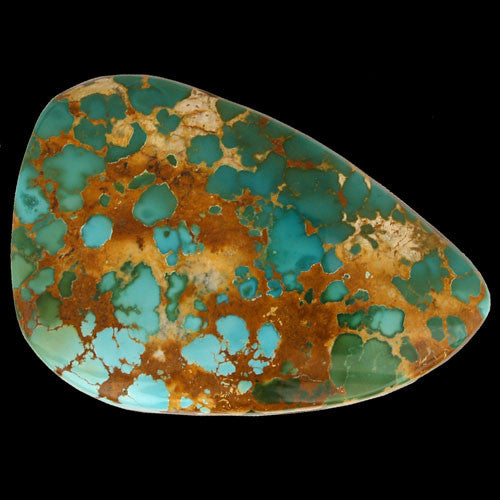
Natural Gem Grade 79.5cts Emerald Valley Turquoise Cabochon (#15)
$2,385.00
Natural Turquoise Cabochon
1 7/8" x 1 1/4"
From the Blue Gem mine south of Battle Mountain, Nevada, deep in the heart of Mother Earth, comes a stunning example of what Nature can produce under the right circumstances. This 79.5-carat gem is like none other, and there will never be another, so get it while you can.
We offer a 100% satisfaction guarantee on every purchase.
Blue Gem or Emerald Valley Turquoise
Blue Gem turquoise occurs in argillized quartz monzonite cut by two limonite-stained sheer zones, one trending N 35 o W and dipping 75 o NE, the other trending N, 25 o E and dipping 55 o NW. An extensive breccia zone about 10 feet wide is developed between the two bounding sheers. Exceptionally good quality turquoise forms veins up to three-quarters of an inch thick along the shears. Pyrite-bearing quartz veins are closely associated with the turquoise.
The Blue Gem mine was at one time located deep underground, accessed by tunnels as deep as 800 feet. This is of interest because the Blue Gem Mine and the Bisbee Mine in Arizona are the only two mines (of which we are aware) that turquoise was found that deep in the earth. The Blue Gem mine was once developed in extensive underground workings and open stoops. An audit several hundred feet long on the main structure connected to numerous shorter tunnels and several open stoops. Directly above the main audit was a glory hole some 100 feet long.
Duke Goff first noted the Blue Gem deposit in 1934. It was subsequently leased from the Copper Canyon Mining Co. by the American Gem Co. of San Gabriel, CA., owned by Doc Wilson and his sons, Del and William. The company operated the property until 1941 when the outbreak of the war caused a shortage of experienced miners. Both Del and William Wilson were called into the Army for the duration of the war, and this compelled the closing of the mine. Consequently, the lease was allowed to lapse and work was abandoned. In 1950 Lee Hand and Alvin Layton of Battle Mountain leased the mine.
Production of turquoise at the Blue Gem lease in the early days of the operation was enormous. Although there is no exact information, it is reported that the output amounted to nearly
$1 million in rough turquoise. The mine is still active, although Duval Corp is currently in the center of a major copper deposit developing it.
Pyrite in Blue Gem is unusual to see but not unheard of. Very little large material ever came out of Blue Gem, the majority found was small 1-mm "bleeder" veins and tiny nuggets which was perfect for Zuni inlay and fine needlepoint, petit-point and snake-eyes jewelry. Blue Gem turquoise was very popular in the late 1930's and 40's and was commonly used in the Fred Harvey "tourist jewelry" that is so collectable today. Blue Gem turquoise is extremely hard and stands up well to the test of time.
Blue Gem turquoise is a rare, valuable and historic American treasure. Quality Blue Gem Turquoise has been gifted with a wide range and variety of color. Because Blue Gem turquoise is very hard, a high polish is associated with this stone, and unlike most turquoise, won't easily change color. This turquoise has a unique character and many different looks all of which are striking, full of wonder and pleasing to the eye.
Production of the mine started about 1934 and continued into the 1970's. Blue Gem Turquoise is still some of the finest turquoise ever found, and unlike most turquoise mines, (in which the majority mined is chalky and only usable if stabilized) most of the turquoise found there was of gem-quality. Today the Blue Gem mine is not viable; it sits in the middle of a huge mining operation. The emphasis is on precious metals and the extraction of turquoise is considered more of a hindrance in the mining process rather than an asset. Even the ever-popular "Dump Diving" for turquoise through the overburden is not tolerated due to the very real danger of becoming buried in a slide. Insurance factors, equipment hazards, high explosives and safety issues along with a lack of interest from the mining company keep Blue Gem turquoise unavailable to the world, at least for now.
Related legends:
Precious Stones
Turquoise; Precious stones have symbolic implications. For example, turquoise if a "collective term for all the precious stones, wealth, or mixed offerings. Good fortune is attributed to this stone." Both white shell and turquoise are emphasized in Kinaalda? More about this legend
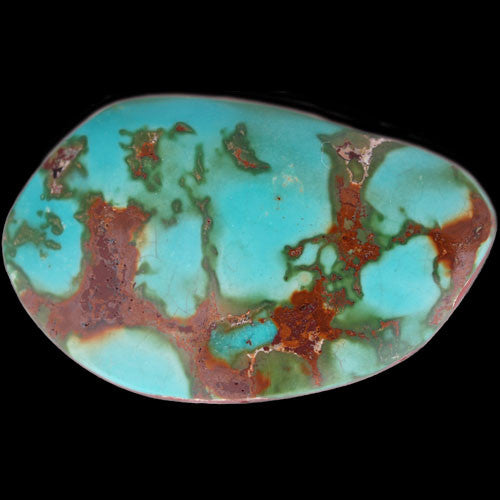
Natural Gem Grade 83cts Blue Gem Turquoise Cabochon (#02)
$2,075.00
Natural Turquoise Cabochon
2" x 1 1/4"
Barry has finally turned loose of one of the great stones he has sequestered over the years. From a collection he acquired almost 20 years ago, Barry has protected this large piece of Blue Gem turquoise for about two decades. Get it now before he realizes just what he is giving up.
We offer a 100% satisfaction guarantee on every purchase.
Blue Gem Turquoise Cabochon
Blue Gem turquoise occurs in argillized quartz monzonite cut by two limonite-stained sheer zones, one trending N 35 o W and dipping 75 o NE, the other trending N, 25 o E and dipping 55 o NW. An extensive breccia zone about 10 feet wide is developed between the two bounding sheers. Exceptionally good quality turquoise forms veins up to three-quarters of an inch thick along the shears. Pyrite-bearing quartz veins are closely associated with the turquoise.
The Blue Gem mine was at one time located deep underground, accessed by tunnels as deep as 800 feet. This is of interest because the Blue Gem Mine and the Bisbee Mine in Arizona are the only two mines (of which we are aware) that turquoise was found that deep in the earth. The Blue Gem mine was once developed in extensive underground workings and open stoops. An audit several hundred feet long on the main structure connected to numerous shorter tunnels and several open stoops. Directly above the main audit was a glory hole some 100 feet long.
Duke Goff first noted the Blue Gem deposit in 1934. It was subsequently leased from the Copper Canyon Mining Co. by the American Gem Co. of San Gabriel, CA., owned by Doc Wilson and his sons, Del and William. The company operated the property until 1941 when the outbreak of the war caused a shortage of experienced miners. Both Del and William Wilson were called into the Army for the duration of the war, and this compelled the closing of the mine. Consequently, the lease was allowed to lapse and work was abandoned. In 1950 Lee Hand and Alvin Layton of Battle Mountain leased the mine.
Production of turquoise at the Blue Gem lease in the early days of the operation was enormous. Although there is no exact information, it is reported that the output amounted to nearly
$1 million in rough turquoise. The mine is still active, although Duval Corp is currently in the center of a major copper deposit developing it.
Pyrite in Blue Gem is unusual to see but not unheard of. Very little large material ever came out of Blue Gem, the majority found was small 1-mm "bleeder" veins and tiny nuggets which was perfect for Zuni inlay and fine needlepoint, petit-point and snake-eyes jewelry. Blue Gem turquoise was very popular in the late 1930's and 40's and was commonly used in the Fred Harvey "tourist jewelry" that is so collectable today. Blue Gem turquoise is extremely hard and stands up well to the test of time.
Blue Gem turquoise is a rare, valuable and historic American treasure. Quality Blue Gem Turquoise has been gifted with a wide range and variety of color. Because Blue Gem turquoise is very hard, a high polish is associated with this stone, and unlike most turquoise, won't easily change color. This turquoise has a unique character and many different looks all of which are striking, full of wonder and pleasing to the eye.
Production of the mine started about 1934 and continued into the 1970's. Blue Gem Turquoise is still some of the finest turquoise ever found, and unlike most turquoise mines, (in which the majority mined is chalky and only usable if stabilized) most of the turquoise found there was of gem-quality. Today the Blue Gem mine is not viable; it sits in the middle of a huge mining operation. The emphasis is on precious metals and the extraction of turquoise is considered more of a hindrance in the mining process rather than an asset. Even the ever-popular "Dump Diving" for turquoise through the overburden is not tolerated due to the very real danger of becoming buried in a slide. Insurance factors, equipment hazards, high explosives and safety issues along with a lack of interest from the mining company keep Blue Gem turquoise unavailable to the world, at least for now.
Related legends:
Precious Stones
Turquoise; Precious stones have symbolic implications. For example, turquoise if a "collective term for all the precious stones, wealth, or mixed offerings. Good fortune is attributed to this stone." Both white shell and turquoise are emphasized in Kinaalda? More about this legend
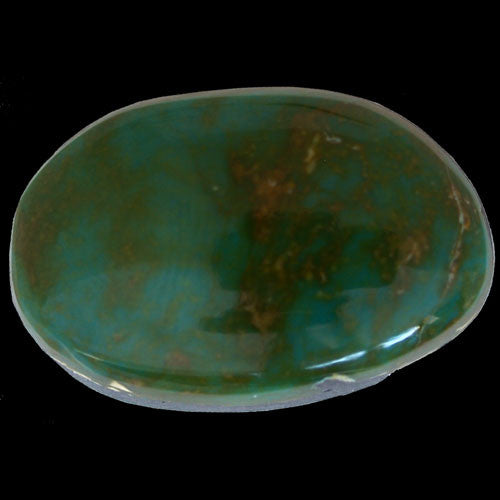
Natural Gem Grade Persian 28.3cts Turquoise Cabochon (#03)
$339.00
Natural Turquoise Cabochons
1 1/8" x 3/4"
This cabochon of Armenian "Persian" turquoise came to us through John Huntress and Bruce Eckhardt. It came to them through an Armenian citizen looking to pedal turquoise in New Mexico. Glad they took the bait. This is a fabulous stone of some of the hardest and well-formed material we have seen. It surely came from an outstanding cache of turquoise.
We offer a 100% satisfaction guarantee on every purchase.
Persian Turquoise
In the Southwest, we tend to take turquoise for granted; yet it has been labeled the “Gemstone of the Centuries”. Over 7,500 years ago, slave convoys were sent into the Sinai Peninsula to pluck pieces of the blue gem from the rocks where it had formed. In ancient Egypt, turquoise was believed to have mystical powers and appeared in amulets and talisman representing their gods Amum and Isis. A gold and carved turquoise bracelet was found on the mummified arm of Queen Zer, a ruler during the first dynasty of Egyptian pharaohs. The four bracelets found in her burial are the earliest known examples of precious metal jewelry.
The Middle East emerged as the great purveyor of turquoise, supplying the ancient Egyptians, Nubians, Greeks and Romans. It is believed the name was derived from the French word, Turquie, a reference to the Turkish traders first bringing the rich blue stones to the European continent. It was assumed that the brilliant blue and green stones originated in Turkey when, in fact, they were most likely extracted from mines in the Sinai Peninsula and the Alimersai Mountain in Persia (Iran).
Related legends:
Precious Stones
Turquoise; Precious stones have symbolic implications. For example, turquoise if a "collective term for all the precious stones, wealth, or mixed offerings. Good fortune is attributed to this stone." Both white shell and turquoise are emphasized in Kinaalda? More about this legend
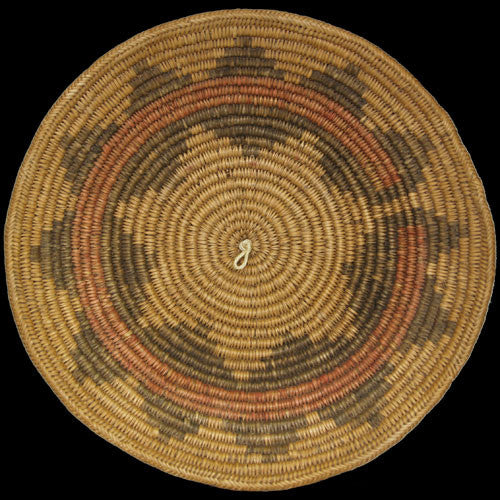
Navajo 1960's Ceremonial Basket (#14)
$850.00
Navajo Baskets
13 3/4" x 2 1/2" deep
Rounds: 22
Classic Navajo wedding baskets have become highly prized and difficult to acquire. At Twin Rocks Trading Post, however, we have located a nice stash of them for distribution to our customers. According to Navajo legend, placing your wealth in these weavings will ensure success and richness. This nice specimen will surely help with the task. Heck, I feel wealthier already.
We offer a 100% satisfaction guarantee on every purchase.
Related legends:
Navajo Ceremonial Baskets
The Navajo wedding basket also reflects many values of traditional life and so often contains all six sacred mountains, including Huerfano and Gobernador Knob, though the size of the basket may determine the numher of mountains in the design. The center spot in the basket represents the beginning of this world, where the Navajo people emerged from a reed? More about this legend
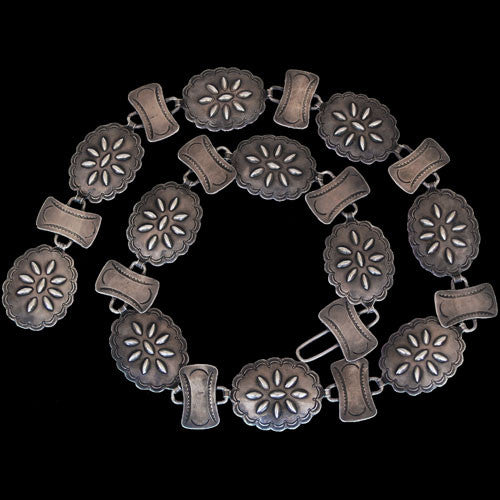
Navajo 1960's Sterling Silver Antiqued Chain Link Concho Belt (#50)
$650.00
Navajo Jewelry
32" long
Patina, experience and years of enjoyment, that’s what this Concho belt from the 1960s says to us. With is folksy style and long use; this belt has had many an interesting time. Get this one on your waste and let the fun begin, again.
We offer a 100% satisfaction guarantee on every purchase.
Related legends:
Silversmith Work
When and how the Navajo acquired the art of working metals is unknown but there are reasons for supposing that it was introduced among them, or at least more developed and improved upon by them, since the time they have occupied their present country?

Navajo 21 Stone Sleeping Beauty Turquoise Buckle (#45)
$650.00
Navajo Jewelry
3 1/4" x 2 1/2"
Lucky 21 is what this piece should be called. Made sometime in the 1960s or 1970s, the classically designed belt buckle has twenty-one stunning pieces of deep blue Sleeping Blue turquoise set in a sterling silver mounting. Although the artist’s name has faded from memory, this buckle will capture and hold your attention. Get it on . . . your belt.
We offer a 100% satisfaction guarantee on every purchase.
Sleeping Beauty Turquoise
The Sleeping Beauty turquoise mine is located seven miles from Globe, Arizona. The mine is one of the largest producers of turquoise in North America. The mine, and the turquoise extracted from it, derives its name from Sleeping Beauty Mountain, which at one time was part of the Copper Cities operation. The center of the copper mine is located at approximately 33o24"13.23"N. 110o53'34. 60"W, at an elevation of 1224 feet. Sleeping Beauty Turquoise Mining is presently owned and operated by Monty Nichols.
For many centuries before the first Europeans made their way into Arizona, turquoise was being mined on the slopes of Sleeping Beauty Mountain. The Salado and other ancient peoples mined the beautiful sky stone from several surface outcroppings located in the vicinity, including Pinto Valley. It is believed that Spanish explorers were the first Europeans to locate the source of Sleeping Beauty sometime around the 1860s. By the 1870s, small underground mines pockmarked the hills surrounding present day Globe.
Cities Service Company started the Copper Cities Mine (commonly called the Sleeping Beauty Mine) in 1952 and operated it until the Pinto Valley mine opened in 1972. During the 1960s, L.W. Hardy had the contract to mine turquoise, both at Sleeping Beauty and at Castle Dome, later called the Pinto Valley Mine. Formerly a meat cutter at a market in Miami, Hardy recognized early on that turquoise was more valuable as a gemstone than the associated copper.
By the time the turquoise boom began, Hardy had contracts with mining companies in Miami, Kingman and elsewhere. He also developed a method for stabilizing low-grade, porous turquoise with pressure-impregnated hot acrylic resin, which hardened the stone and improved the color.
Hardy's mining methods were primitive when compared with current operations. Hardy's workers sat in a ditch ripped by a bulldozer and hand picked the stone from waste-rock. Hardy mined turquoise at Sleeping Beauty for 22 years, getting about 45 percent recovery, and leaving the rest in waste dumps.
Monty Nichols received the contract to mine Sleeping Beauty turquoise in 1988, and began using modern mining methods to develop the property. Nichols drills and blasts the overburden, hauling it to the abandoned Copper Cities pit, which now contains the recycled tailings from Miami Copper Company's No. 5 tailing dam. The old dam dominated the eastern skyline of downtown Miami until recently. The year Nichols acquired the contract; he began a two-year project to remove 5,000.000 tons of overburden. Located half way up the side of an open pit mine, the narrow turquoise-bearing zone has about 400 feet of hard waste rock on top of it. In order to move sideways into the ore-body, a whole slice of the mountain had to be removed.
To avoid fracturing the turquoise, Nichols was careful not to blast too near the turquoise-bearing strata. That layer is more crumbly, so the miners can rip it and dump it over screens, separating the material by size. No crushers are used, again to avoid fracturing the gemstone, and the different sized rock is hauled up to a wide mine bench where conveyor belts move the material through three buildings. There, workers handpick turquoise from the broken rock. The buildings are vented with filtered air to eliminate workers' exposure to dust, and well insulated to keep them comfortable in any weather. It is a far cry from the old methods of mining. Anywhere from 30 to 40 people work at the mine at any one time, depending on how much mining there is to do.
Fifty years ago, mine workers filled lunch buckets with the colorful rock, even though it was reason for immediate termination. Old habits die hard, and some people still think it is okay to sneak in and try to pick turquoise. As a result, security is tight in and around the mine. Motion detectors, night vision cameras and 24/7 roving patrols are used, so the only turquoise leaving the property now is being shipped to markets around the world.
Italy is the largest volume buyer of Sleeping Beauty turquoise, with Germany and Hong Kong following closely behind. These customers buy the best grade for their exclusive jewelry. Jewelry makers in India and Spain also receive Sleeping Beauty turquoise, while in the U.S., Gallup and Albuquerque are the largest consumers.
The Sleeping Beauty turquoise mine produces a uniform light to medium blue turquoise with rare finds of deep, dark blue. Because of its uniformity, it has been a favorite of the Zuni Pueblo. Zuni silversmiths often use it in channel inlay and various types of cluster work that require large numbers of small, perfectly matched stones. The Sleeping Beauty mine has been one of the larger producers of rough turquoise in the United States, although today much less good turquoise is being produced than in the past.
Sleeping Beauty turquoise is noted for its solid, light blue color with no matrix; the host rock is usually granite. Nichols says the mine is producing about 1,600 pounds a month. Of that, only four percent is natural; most of the turquoise from the mine is altered in some way. Most is enhanced, which is more expensive than stabilization, and sold to large distributors in this country and Europe. Currently most of the turquoise that comes from the mine is from the tons of tailings piles that have been accumulating for decades.
The best of the Sleeping Beauty turquoise is comparable to that found in the Middle East. It is thought that large quantities of Sleeping Beauty turquoise is taken overseas and smuggled into, then out of, Iran to be sold as “Persian” turquoise.
Related legends:
Silversmith Work
When and how the Navajo acquired the art of working metals is unknown but there are reasons for supposing that it was introduced among them, or at least more developed and improved upon by them, since the time they have occupied their present country?
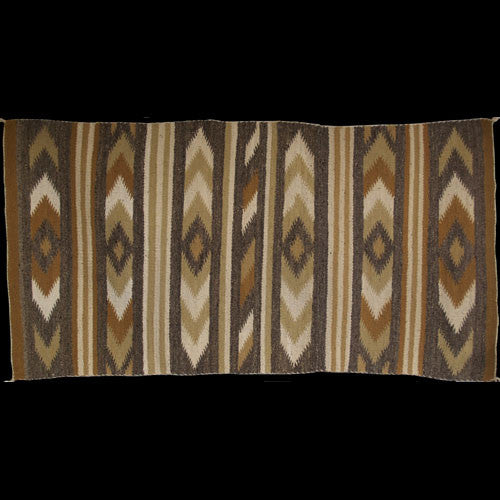
Navajo Crystal Handspun and 100% Vegetal Dye Rug (#48)
$950.00
Navajo Rug
59" x 29 1/2"
This wonderful rug from the Stephen Zolock collection is made with vegetal dyes and woven from hand-spun wool. Woven in the 1960s, this weaving is subtle and well made.
We offer a 100% satisfaction guarantee on every purchase.
Related legends:
Crystals
First Man burned a crystal for a fire. The crystal belonged to the male and was the symbol of the mind and of clear seeing. When First Man burned it, it was the mind's awakening? More about this legend
Weaving
After the medicine woman told the people about the prayersticks she told them that there was a place in the underworld where two rivers crossed. It was called ni tqin'kae tsosi, fine fiber cotton (Indian hemp). There were two persons who brought the seed of that plant, they were spiders. They said that the people were to use the plant instead of skins for their clothing. So this seed was planted in the earth? More about this legend
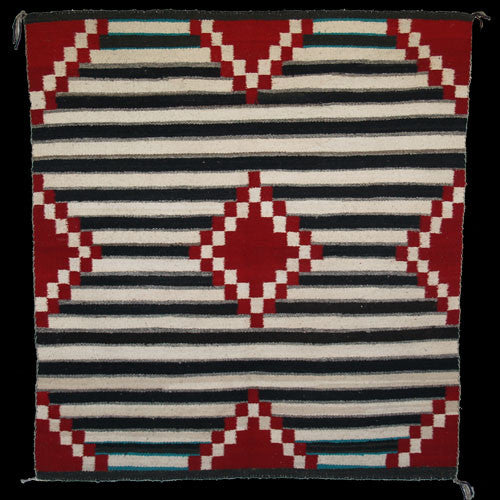
Navajo Handspun Chief Blanket (#45)
$0.00
Navajo Blanket
44" x 49"
Much flora and fauna gave there all in the creation of this third phase Chief's blanket. Hand spun wool, acrylic and vegetable dyes are what this rug is made from. Back in the 1960s a tasteful and talented Navajo weaver created this alluring weaving. The time and effort it took are undocumented, but be assured it took a great deal of each. Blankets such as this are uncommon in today's market, not many people want to shear the sheep, clean the wool, dye it, spin it and then weave the rug. Too much work! See, touch and own a blast from the past with this weaving.
We offer a 100% satisfaction guarantee on every purchase.
Related legends:
Weaving
After the medicine woman told the people about the prayersticks she told them that there was a place in the underworld where two rivers crossed. It was called ni tqin'kae tsosi, fine fiber cotton (Indian hemp). There were two persons who brought the seed of that plant, they were spiders. They said that the people were to use the plant instead of skins for their clothing. So this seed was planted in the earth? More about this legend
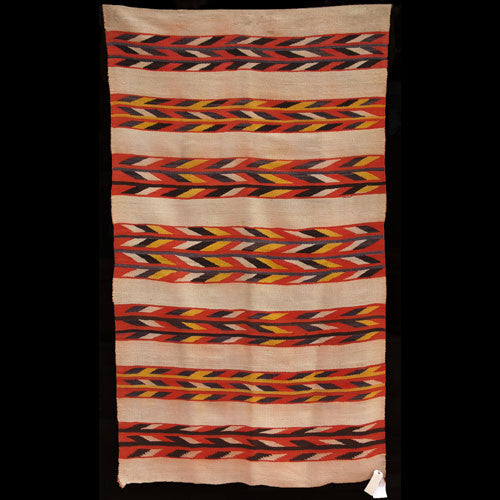
Navajo Handspun Feather Pattern Blanket (#49)
$1,750.00
Navajo Rug
52" x 86"
This banded rug from the Steve Zolock collection was made in the 1940s and collected by Steve in the 1960s. While it shows a little wear, that’s to be expected after about 75 years. The colors are an interesting blend and the wool soft and supple. Steve has asked us to find a new home for this beauty, so if your abode, office or cabin wants one this is for you.
We offer a 100% satisfaction guarantee on every purchase.
Related legends:
Weaving
After the medicine woman told the people about the prayersticks she told them that there was a place in the underworld where two rivers crossed. It was called ni tqin'kae tsosi, fine fiber cotton (Indian hemp). There were two persons who brought the seed of that plant, they were spiders. They said that the people were to use the plant instead of skins for their clothing. So this seed was planted in the earth? More about this legend

Navajo Handspun Wool Yei Rug (#50)
$2,975.00
Navajo Rug
77" x 36"
Every once in a while a historic weaving appears at Twin Rocks Trading Post that makes us stand straight up and shout, “WOW!” Well, this 1930s Yei weaving is precisely one such rug. Featuring the entire cadre of dancers, including Water Sprinkler, Talking God and six assistants, this rug has color, big time funk, hand-dyed wool, no wear and personality enough to keep you dancing for a lifetime. Say it with me now, “WOW!”
We offer a 100% satisfaction guarantee on every purchase.
Related legends:
Yei
Every creature, every aspect of nature has its holy people . . . . even the stinkbug. Sometimes you can see them, if only for an instant. They are represented, some of them, by colors: the blue sky, the evening dusk, the night these are holy people and one prays to them. There are iron people, crystal people, then the other rocks "and such people." There are dawn people, twilight people, air, thunder, and cloud people. One does not talk about such things in nature when they and their holy people are present.
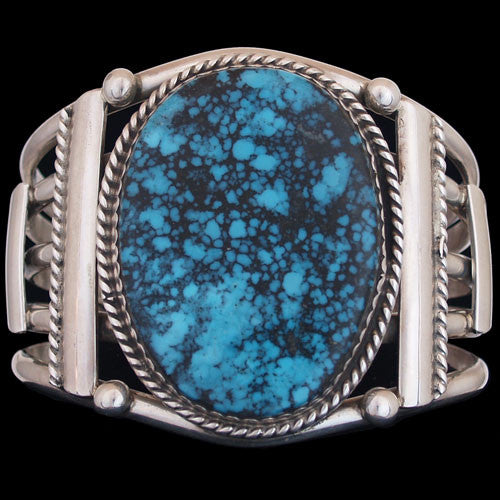
Navajo Large Tibet Turquoise Stone Bracelet (#54)
$750.00
Total inner circumference including opening: 6 7/8"
Opening: 1 1/8"
This traditional style bracelet has plenty of mass and is set with a monumental stone. This bracelet came to us through an estate, and it does not seem to have been worn for any appreciable amount of time. Although we are unfamiliar with the artist, the cuff is Navajo in style and is in pristine condition. The natural stone comes from Tibet and is of high quality. The bracelet is hand fabricated and extremely well made.
Related legends:
Silversmith Work
When and how the Navajo acquired the art of working metals is unknown but there are reasons for supposing that it was introduced among them, or at least more developed and improved upon by them, since the time they have occupied their present country?

Navajo Natural Gem Grade Spiderweb Kingman Turquoise Bracelet (#27)
$3,200.00
Turquoise Jewelry
Inner Circumference: 5 3/4"
Opening: 1 1/2"
Total: 7 1/4"
Width: 2 1/4"
Hot dang that is some nice rock. You bet it is! The turquoise in this bracelet is super high-grade natural Kingman and it is definitely way, way nice. The silver work was done sometime in the late 1960s or early '70s by an unknown Navajo silversmith. This cuff is signed with a rocking M, and stamped "Sterling" and "Navajo". The piece is of the old style, having been created of heavy silver with deeply stamped impressions. This bracelet is big and beautiful, and a bountiful example of just how extraordinary Kingman turquoise can be.
We offer a 100% satisfaction guarantee on every purchase.
Kingman Turquoise
Kingman Turquoise comes from a large open-pit copper mine in the Mineral Park Mining District, northwest of Kingman, Arizona and was one of the largest turquoise mines in this country. The area lies in high desert country at an elevation of 3,345 feet and is surrounded by three mountain ranges. The mining district around Kingman, Arizona has always been a large producer of turquoise, at one time the world's largest. First mined by Indians, this area was home to the most extensive prehistoric workings found in Arizona.
The modern production of turquoise dates back to the early 1880’s when James Haas rediscovered these ancient Kingman area mines. Much of the turquoise occurred as seams, masses and veins. The color of natural Kingman turquoise can range from light blue to very dark blue and sometimes tints of green. The matrix is from white, light brown to black and frequently flecked with pyrite and times quartz. The mine became famous for its rounded, bright blue nuggets with black matrix. Few turquoise mines produced nuggets, especially of this quality. In its high-grade form it has always been considered among the top quality American turquoise. With so many thousands of pounds of good quality turquoise produced in the Kingman area over the last one hundred years it is hard to believe that today very little high-grade Kingman turquoise is available.
Other names for Kingman turquoise: Ithaca Peak, The Wall, Tiffany, Courtland, Az., Gleeson
Most desirable: Deep Blue with molybdenum pyrite; Real blue with pyrite; Bird's eye; Water Web; Nuggets
Related legends:
Precious Stones
Turquoise; Precious stones have symbolic implications. For example, turquoise if a "collective term for all the precious stones, wealth, or mixed offerings. Good fortune is attributed to this stone." Both white shell and turquoise are emphasized in Kinaalda? More about this legend

Navajo Rectangular Chinese Turquoise Stone Silver Bracelet (#07)
$490.00
Navajo Jewelry
Hand Stamped Sterling Silver Bracelet set with One Rectangular Chinese Turquoise Stone
Size - 6 3/4
Inner Circumference - 5 5/8"
Opening - 1 1/4"
We offer a 100% satisfaction guarantee on every purchase.
Related legends:
Silversmith Work
When and how the Navajo acquired the art of working metals is unknown but there are reasons for supposing that it was introduced among them, or at least more developed and improved upon by them, since the time they have occupied their present country?

Navajo Royston Turquoise and Sterling Silver Concho Belt (#48)
$1,800.00
Turquoise Jewelry
54" long
The 1960's were a great time for Navajo jewelry, but not so good for recognizing the artist. This Concho belt has a hallmark on the back of the buckle, but it is not definitive enough to tell us who the artist was. So often we see superb artwork without a hallmark. Such a thing was mostly not thought of back then. This very appealing concho belt is a perfect example of that occurrence. The workmanship is that of a master silversmith and his taste in turquoise was top shelf. Who ever he or she was, we pay them tribute today by presenting their art with a heartfelt "Thank you!"
We offer a 100% satisfaction guarantee on every purchase.
Royston Turquoise
The Royston Mining District lies on the Nye-Esmerelda County line, about 24 miles northwest of Tonopah, Nevada. In this area, turquoise mines are scattered for nearly a mile along a shallow canyon. Because it involves many small producers, the Royston district is one of the better-known turquoise mining areas in Nevada. Three of the district's more important turquoise mines are the Royal Blue, Bunker Hill and the Oscar Wehrend.
The Royal Blue mine constitutes the main turquoise workings in the district. This turquoise shows as fine-grained, altered porphyry, which is soft in places, although much of it has been hardened by silification. The turquoise is found principally in veinlets and seams, with minor lenses and nodules. The veinlets and lenses range from a fraction of an inch to more than an inch in thickness. Masses of turquoise, filling brecciated matrix, have, however, been found more than five inches thick. Lens shaped pieces of turquoise weighing an ounce or two are not uncommon, and one piece weighing nearly a pound and a half were found.
Royston turquoise ranges in color from dark and pale blue to various shades of green. Some of the dark blue turquoise has a slightly greenish cast, and some is nearly pure blue in color. The dark blue turquoise and that with a greenish cast are very fine grained and hard; the lighter colored ore is generally softer. The best turquoise is often found in limonite stained rock, and the pale blue, softer turquoise is found in light colored, softer porphyry. The quality of the best pure blue stones from the Royal Blue is equal to that found in any American mine and the matrix is especially fine.
The hard turquoise veins and nuggets are coated with a crust or stain of dark to light shading, and at times include a yellow limonite. This stain penetrates the turquoise along seams and branching cracks, producing attractive patterns and contrasts of color. Some large specimens have consisted of a patchwork of dark blue with a slightly greenish tint, marked in places with a very dark red-brown matrix. These cut gems can exhibit exceedingly wide variations of shading, and the matrix contrasts are often striking. Great spider webbing in green or blue nuggets and unusual scenic turquoise pieces are a hallmark of Royston
Two prospectors named Workman and Davis, who later sold the mine to William Petry for $3,000.00, discovered the mine in 1902. Petry improved the mine to the point of assuring its production, and, in 1907, sold it to The Himalaya Mining Co., which was owned by Julius Tannenbaum of Los Angeles and New York. Tannenbaum owned a number of mines in Nevada and California. During 1908 and 1909, the property was systematically and actively worked under the directions of Julius Goldsmith, Tanenbaum's son-in-law. Tannenbaum died suddenly about 1910, and Goldsmith hurried east to settle the estate. Shortly afterwards, he ordered operations abandoned and about 1911 sold the mine back to Petry. Petry and W. I. Miller, who had been Petry's mine boss, operated the mine for a time, and then leased it to Lee Hand and Bert Kopenhaver. Hand and Kopenhaver worked the mine dumps for a time, and then bought the mine outright from Petry. Kopenhaver later sold his share to Charley Bona. Hand and Bona worked the mine periodically, and in 1936 Bona sold his interest to Ted Johnson. In 1940 Johnson sold his share to Lee Hand.
The Otteson family now works the mine. The Otteson story began in 1944 with Lynn Otteson. Lynn brought his family to Nevada to mine turquoise and leased his first Royston claim from Lee Hand. At that time, Hand owned approximately 30 claims in the Royston district. The Otteson family has owned or leased turquoise claims in this district for the past 60 years. The Royal Blue mine has been one of the major turquoise producers in the state of Nevada. For some time, the mine produced as much as 1,250 pounds of turquoise a month, and several times has exceeded that amount.
Petry, at the time he sold the mine to Hand and Kopenhaver, declared that the Royal Blue had produced more gem quality turquoise than any mine in the United States. He placed the value of cut stones taken from the mine at more than $5 million. There is no adequate estimate of the value of gems produced from the mine in the years since that time.
The Bunker Hill is about half a mile north of The Royal Blue. In this mine, turquoise occurs in altered quartzite and ranges from royal blue to greenish blue with brown with white matrix. Turquoise is mainly in the form of slabs from 1/16 of an inch to a full inch thick. The mine was discovered in 1927 by Roy Palfreyman and Bert Kopenhaver, and was originally opened as a small shaft about 20 feet deep. As the turquoise was unearthed, the shaft was widened along the seam into a long stope, which was eventually opened into a glory hole. Polfreyman and Kopenhaver took out about $30,000 worth of turquoise, then sold to the owners of the Royal Blue mine, who produced about $75,000 worth of material. The mine eventually was incorporated into the Royal Blue group of claims.
The Oscar Wehrend mine, in the Royston district, is about 1/3 of a mile from the main workings of the Royal Blue. The turquoise is in highly altered rocks, where it forms seams, coatings and nodules as large as 2 inches thick. It is mostly soft, pale, and not of very good quality. Its color and hardness can, however, be improved by artificial means. Oscar Wehrend discovered the deposit in 1909, but Lee Hand conducted much of the work. Production from the property has been small.
The Royston Mine was originally worked as a silver mine in the late 1800s, Large deposits of high quality turquoise led Tiffany's of New York to incorporate quality green and blue turquoise stones from the Royston Hills into their jewelry lines prior to WWII. There was a brief surge of Royston turquoise production in the 1970s, and the Royston district is still producing limited amounts of high quality turquoise. The turquoise currently being produced from the Royston district is mined by Dean and Danny Otteson, and is coming from the Royal Royston claim.
Related legends:
Silversmith Work
When and how the Navajo acquired the art of working metals is unknown but there are reasons for supposing that it was introduced among them, or at least more developed and improved upon by them, since the time they have occupied their present country?

Navajo Sterling Silver Handstamped Bolo Tie (#43)
$445.00
Navajo Jewelry
2 1/4" x 2 3/4"
Bolo ties are the official neckwear of Arizona, New Mexico, Texas and Bluff, Utah. With that kind of endorsement, they are spreading like wildfire on the prairie. As such, you may want to snap up this beautifully crafted stamped sterling silver example of the best in Navajo-Western fashion.
We offer a 100% satisfaction guarantee on every purchase.
Related legends:
Silversmith Work
When and how the Navajo acquired the art of working metals is unknown but there are reasons for supposing that it was introduced among them, or at least more developed and improved upon by them, since the time they have occupied their present country?

Navajo Sterling Silver Naja Coral Necklace (#46)
$710.00
Navajo Jewelry
Necklace: 24"
Pendant: 1 3/4" x 2 1/4"
Sterling silver, hand-made beads, blood red Mediterranean coral, horseshoe naja and Navajo construction combine to make for one sweet set. This combination of stone and metal speak history, Navajo culture and good value all at the same time.
We offer a 100% satisfaction guarantee on every purchase.
Related legends:
Silversmith Work
When and how the Navajo acquired the art of working metals is unknown but there are reasons for supposing that it was introduced among them, or at least more developed and improved upon by them, since the time they have occupied their present country?

Navajo Two Grey Hills Rug (#53)
$1,600.00
49 1/2" x 34 3/4"
This very nice Two Grey Hills rug was woven approximately in the 1970’s. Its warm earth tones are why it is described as such. It’s a fine example of the soft colors and tight weaving associated with such Navajo rugs. We do not know the weaver because the original buyers collection, of which it came from did not keep track of the name. But the artist surely must have been accomplished.
Related legends:
Two Grey Hills Rugs

Navajo XL Two Grey Hills Rug (#52)
$7,950.00
9' 1 1/2" x 5' 6"
This is a really majestic, old style Two Grey Hills weaving circa 1920's or 30's. Because of its age, we do not know the weaver but we do know she was a master artist. The rug is made completely of hand-shorn wool and is hand carded and spun as well. The colors are completely natural except for the red, aniline dyed edge cords. This is a heavy well-made weaving that has seen very little wear and shows no damage from ultraviolet light. This weaving is a classic example of a big, bold, beautiful Navajo textile.
Related legends:
Two Grey Hills Rugs

Navajo/Hopi Sterling Silver Parrot Symbol Pendant (#53)
$290.00
This pendant came to us through and estate and we were more than happy to see it. We have been arguing its origin for some time now and have narrowed our hypothesis to Hopi, with a Navajo twist. The design work is Hopi with the parrot and kiva step design, but the texture seems more Navajo. At any rate, the pendent is extremely attractive and has no trouble standing out in either cultural arena.
Related legends:
Silversmith Work
When and how the Navajo acquired the art of working metals is unknown but there are reasons for supposing that it was introduced among them, or at least more developed and improved upon by them, since the time they have occupied their present country?

Stunning 8 Strand Mediterranean Coral Necklace (#56)
$2,900.00
33 1/2" long
Indians began trading with the Spanish as early as the 1400s. Soon thereafter, coral became a desired commodity. Coral strands such as these were imported from the Mediterranean in the 1970s. These have an attractive orange/red color and are interspersed with sterling silver beads. The "squaw wrap" collar is done with chrome colored leather, which makes for a soft and comfortable feel around the neck.
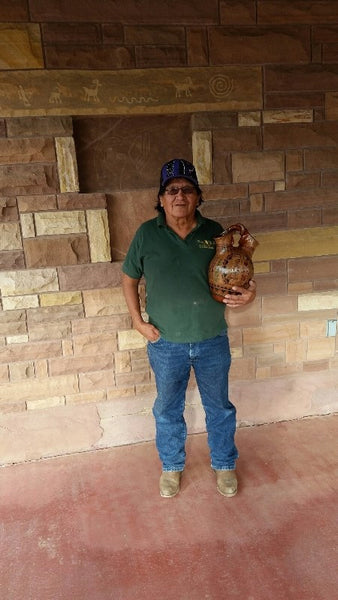
TESTING: some gift under $200
$10.00
